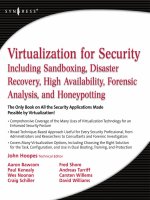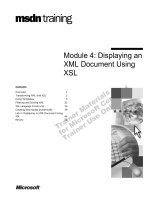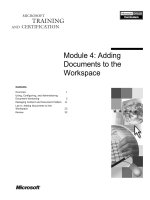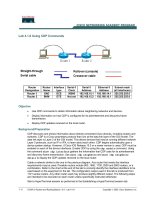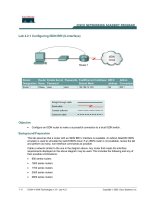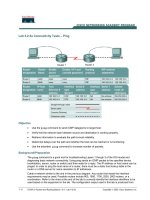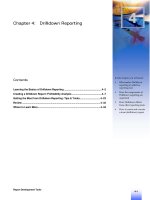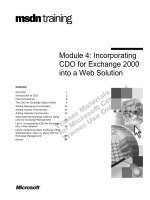Tài liệu JIRA 4 Essentials ppt
Bạn đang xem bản rút gọn của tài liệu. Xem và tải ngay bản đầy đủ của tài liệu tại đây (19.34 MB, 352 trang )
www.it-ebooks.info
JIRA 4 Essentials
Track bugs, issues, and manage your software
development projects with JIRA
Patrick Li
BIRMINGHAM - MUMBAI
www.it-ebooks.info
JIRA 4 Essentials
Copyright © 2011 Packt Publishing
All rights reserved. No part of this book may be reproduced, stored in a retrieval
system, or transmitted in any form or by any means, without the prior written
permission of the publisher, except in the case of brief quotations embedded in
critical articles or reviews.
Every effort has been made in the preparation of this book to ensure the accuracy
of the information presented. However, the information contained in this book is
sold without warranty, either express or implied. Neither the author, nor Packt
Publishing, and its dealers and distributors will be held liable for any damages
caused or alleged to be caused directly or indirectly by this book.
Packt Publishing has endeavored to provide trademark information about all of the
companies and products mentioned in this book by the appropriate use of capitals.
However, Packt Publishing cannot guarantee the accuracy of this information.
First published: May 2011
Production Reference: 1160511
Published by Packt Publishing Ltd.
32 Lincoln Road
Olton
Birmingham, B27 6PA, UK.
ISBN 978-1-849681-72-8
www.packtpub.com
Cover Image by Artie Ng ()
www.it-ebooks.info
Credits
Author
Patrick Li
Reviewers
Matthew B. Doar
Stafford Vaughan
Marcin Zręda
Acquisition Editor
Amey Kanse
Development Editor
Alina Lewis
Technical Editor
Kavita Iyer
Copy Editor
Neha Shetty
Project Coordinator
Vishal Bodwani
Proofreader
Josh Toth
Indexers
Monica Ajmera Mehta
Rekha Nair
Graphics
Geetanjali Sawant
Production Coordinators
Alwin Roy
Arvindkumar Gupta
Cover Work
Alwin Roy
Arvindkumar Gupta
www.it-ebooks.info
About the Author
Patrick Li is a senior engineer at AppFusions, the leading Atlassian partner
specializing in delivering Enterprise 2.0 solutions for clients in the United States,
UK, Australia, and Hong Kong.
He has worked in the Atlassian ecosystem for over four years, developing solutions
for Atlassian products and providing expert consulting services. He is one of the top
contributors to the Atlassian community, providing answers and suggestions on the
Atlassian user forum.
He has extensive experience in designing and deploying Atlassian solutions from the
ground up, as well as customizing existing deployments for clients across verticals
like Healthcare, Software Engineering, Financial Services, and Government Agencies.
I would like to thank my family, especially my wife Katherine, who
has been very supportive during all this time. I would also like to
thank everyone who has edited and reviewed the book.
www.it-ebooks.info
About the Reviewers
Matt Doar rst discovered JIRA while writing Practical Development Environments
(O’Reilly, 2005). Since then, his company Consulting Toolsmiths has helped dozens
of organizations to use JIRA the way they want to. He is also the author of a number
of signicant plugins in the Atlassian Plugin Exchange.
Before that, he was a software toolsmith and developer for a number of networking
companies in Northern California. He has a Ph.D. in Computer Science from the
University of Cambridge.
I’d like to thank my dear children Elizabeth, Jacob, and Lucas for all
their questions and my beloved wife Katherine for her patience with
my answers. I think it’s for my family that God has established the
work of my hands (Psalm 90:17).
Stafford Vaughan started using JIRA in 2005 after getting a Software Engineering
degree in Australia and joining CustomWare, Atlassian’s leading services partner.
He is a founding author of Atlassian’s ofcial JIRA training course materials. During
his four years as the Atlassian Training Manager, Stafford worked with many
Fortune 500 companies, government entities, and universities, including NASA,
Intel, Stanford University, The Pentagon, Wells Fargo, and The United Nations.
Stafford currently lives in San Francisco and provides training for organizations in
and around Silicon Valley.
Marcin Zręda specializes in business analysis and quality assurance. He has many
years of experience as a programmer and designer. He is the author of many articles
on JIRA and the owner of the testandtry.com blog. Has implemented JIRA for
many departments that have more than 600 employees. He is currently directing the
department of business analysis in a large international company.
www.it-ebooks.info
www.PacktPub.com
Support les, eBooks, discount offers and more
You might want to visit www.PacktPub.com for support les and downloads related to
your book.
Did you know that Packt offers eBook versions of every book published, with PDF and ePub
les available? You can upgrade to the eBook version at www.PacktPub.com and as a print
book customer, you are entitled to a discount on the eBook copy. Get in touch with us at
for more details.
At www.PacktPub.com, you can also read a collection of free technical articles, sign up for a
range of free newsletters and receive exclusive discounts and offers on Packt books and eBooks.
Do you need instant solutions to your IT questions? PacktLib is Packt's online digital book
library. Here, you can access, read and search across Packt's entire library of books.
Why Subscribe?
Fully searchable across every book published by Packt
Copy and paste, print and bookmark content
On demand and accessible via web browser
Free Access for Packt account holders
If you have an account with Packt at www.PacktPub.com, you can use this to access PacktLib
today and view nine entirely free books. Simply use your login credentials for immediate access.
Instant Updates on New Packt Books
Get notied! Find out when new books are published by following @PacktEnterprise on
Twitter, or the Packt Enterprise Facebook page.
www.it-ebooks.info
Table of Contents
Preface 1
Chapter 1: Getting started with JIRA 7
JIRA architecture 7
High-level architecture 8
Browsers 8
Application services 9
Data storage 9
JIRA installation directory 9
JIRA home directory 10
Installation options 10
Standalone and WAR-EAR distributions 11
Operating systems 11
Databases 11
Application Servers 12
Installing JIRA 13
Installing Java 14
Installing MySQL 15
Conguring MySQL 16
Installing JIRA 18
Conguring JIRA application properties 18
Conguring JIRA application settings (optional) 18
Conguring HTTPS 19
Installing database drivers (optional) 21
Conguring the database connection manual 22
Conguring the database connection (GUI) 24
Conguring JIRA as a Windows service 25
Starting JIRA 26
Summary 30
www.it-ebooks.info
Table of Contents
[ ii ]
Chapter 2: Project Management 31
JIRA hierarchy 31
Project category 31
Projects 32
Issues 32
Fields 33
JIRA projects 33
Project browser 33
Summary tab 35
Issues tab 36
Road Map tab 36
Change Log tab 36
Versions/Components tabs 36
Source/Reviews tabs 37
Project management 37
Creating projects 38
Editing projects 39
Deleting projects 40
Project administration 40
Components 42
Creating components 43
Editing components 43
Deleting components 43
Selecting the default assignee 44
Versions 45
Creating versions 46
Editing versions 47
Deleting versions 47
Project congurations 48
Issue types 48
Creating issue types 49
Editing issue types 50
Deleting issue types 50
Priorities 50
Creating priorities 52
Editing priorities 52
Deleting priorities 52
Arranging priorities 53
Resolutions 53
Creating resolutions 55
Editing resolutions 55
Deleting resolutions 55
Arranging resolutions 56
www.it-ebooks.info
Table of Contents
[ iii ]
Schemes 56
Issue type scheme 56
Notication scheme 58
Permission scheme 58
Issue security scheme 58
Field conguration scheme 58
Screen scheme 58
Issue type screen scheme 59
Workow scheme 59
Help Desk project 59
Creating a new project category 59
Creating a new project 60
Creating new priorities 60
Creating new resolutions 61
Creating issue types 61
Creating an issue type scheme 63
Creating new components 64
Creating new versions 64
See it in action 65
Summary 67
Chapter 3: Issue Management 69
What an issue looks like 69
Creating an issue 71
Editing an issue 72
Deleting an issue 73
Moving an issue between projects 73
Casting vote on an issue 75
Receiving notications about issues 76
Re-assigning issues to others 77
Issues and comments 78
Adding comments 78
Managing your comments 79
Creating a Permalink 79
Attachments 80
Enabling attachments in JIRA 80
Attaching les 81
Attaching screenshots 82
Sub-tasks 83
Enabling sub-tasks 83
Creating sub-tasks 84
Issue linking 85
Enabling issue linking 85
www.it-ebooks.info
Table of Contents
[ iv ]
Creating link types 86
Linking issues 87
Issue cloning 89
Cloning an existing issue 89
Time tracking 90
Enabling time tracking 90
Specifying original estimates 91
Logging work 92
Help Desk Project 93
Conguring sub-tasks 93
Conguring time tracking 93
Enabling issue linking 94
Putting it together 95
Summary 99
Chapter 4: Field Management 101
Built-in elds 101
Custom elds 102
Custom eld types 102
Simple elds 103
JIRA specialized elds 103
Multi elds 104
Searchers 104
Custom eld context 105
Managing custom elds 105
Adding a custom eld 106
Editing/Deleting a custom eld 108
Conguring a custom eld 109
Adding custom eld contexts 110
Conguring select options 112
Setting default values 113
Field conguration 114
Adding a eld conguration 115
Editing/Deleting a eld conguration 115
Copying a eld conguration 116
Managing eld congurations 117
Field description 118
Field requirement 118
Field visibility 119
Field rendering 119
Screens 121
Field conguration scheme 121
Managing eld conguration schemes 121
www.it-ebooks.info
Table of Contents
[ v ]
Adding a eld conguration scheme 122
Editing/Deleting a eld conguration scheme 122
Copying a eld conguration scheme 123
Conguring a eld conguration scheme 124
Associating a eld conguration scheme with a project 125
Help Desk Project 126
Setting up custom elds 127
Setting up eld conguration 128
Setting up a eld conguration scheme 129
Putting it all together 130
Summary 131
Chapter 5: Screen Management 133
Screens 133
Adding a screen 135
Editing/Deleting a screen 136
Copying a screen 137
Conguring a screen 137
Adding a eld to a screen 139
Deleting a eld from screen 139
Reordering elds on screen 139
Screen tabs 140
Adding a tab 141
Editing/Deleting a tab 142
Reordering tabs 142
Screen schemes 143
Adding a screen scheme 144
Editing/Deleting a screen scheme 145
Copying a screen scheme 146
Conguring a screen scheme 147
Adding an association 148
Editing/Deleting an association 148
Issue type screen scheme 149
Adding an issue type screen scheme 150
Editing/Deleting an issue type screen scheme 150
Coping an issue type screen scheme 151
Conguring an issue type screen scheme 151
Adding an association 152
Editing/Deleting an association 153
Activating an issue type screen scheme 154
Help Desk Project 156
Setting up screens 156
Setting up screen schemes 158
www.it-ebooks.info
Table of Contents
[ vi ]
Setting up issue type screen schemes 159
Putting it all together 160
Summary 161
Chapter 6: Workow and Business Process 163
Mapping business processes 163
Workows 164
Managing workows 165
Creating a workow 166
Editing a workow 167
Deleting a workow 167
Copying a workow 168
Importing and exporting a workow 168
Conguring a workow 171
Conguring and publishing a draft 172
Steps and issue statuses 173
Adding a step to a workow 174
Editing a step 174
Deleting a step 175
Transitions 175
Adding a transition between steps 176
Editing a transition 177
Deleting a transition 178
Conguring a transition 178
Conditions 179
Adding a condition to transition 180
Validators 182
Adding a validator to transition 182
Post functions 183
Adding a post function to transition 183
Workow schemes 184
Creating a workow scheme 185
Conguring a workow scheme 186
Assigning a workow to issue type 187
Editing/Deleting an association 188
Editing a workow scheme 188
Deleting a workow scheme 189
Copying a workow scheme 189
Activating a workow scheme 190
Help Desk Project 192
Setting up issue status 193
Setting up the workow 193
Setting up a workow scheme 195
www.it-ebooks.info
Table of Contents
[ vii ]
Putting it all together 196
Summary 198
Chapter 7: E-mail and Notication 199
JIRA and E-mail 199
Mail servers 200
Adding an SMTP mail server 201
Enabling SMTP over SSL 203
Sending a test e-mail 204
Mail queue 205
Viewing the mail queue 205
Flushing the mail queue 206
Events 206
Adding a mail template 208
Adding a custom event 210
Firing a custom event 211
Notications 212
Notication schemes 214
Adding a notication scheme 214
Editing a notication scheme 215
Deleting a notication scheme 215
Copying a notication Scheme 216
Managing a notication scheme 217
Adding a notication 217
Deleting a notication 218
Assigning a notication scheme 219
Receiving E-mails 221
Adding a POP/IMAP mail server 221
Mail handlers 222
Creating an issue handler 223
Create or comment handler 224
Full Comment Handler 224
Non-quoted comment handler 225
Regex comment handler 225
Adding a mail handler 225
Editing and deleting a mail handler 227
Help Desk Project 228
Setting up mail servers 228
Setting up custom events 229
Setting up a notication scheme 229
Setting up notications 230
Putting it together 230
Summary 231
www.it-ebooks.info
Table of Contents
[ viii ]
Chapter 8: Securing your JIRA 233
Users 233
User Browser 234
Adding a user 234
Enabling public signup 235
Enabling CAPTCHA 236
Groups 237
Group Browser 238
Adding a group 239
Editing group membership 239
Deleting a group 240
Project roles 240
Project role browser 241
Adding a project role type 241
Editing a project role 242
Deleting a project role 242
Managing default members 242
Assigning project role members 244
JIRA permission hierarchy 245
Global Permissions 246
JIRA System Administrator versus JIRA Administrator 247
Conguring Global Permissions 248
Granting global permission 248
Revoking global permission 249
Project permissions 250
Permission scheme 252
Adding a permission scheme 253
Editing a permission scheme 253
Deleting a permission scheme 254
Copying a permission scheme 254
Conguring a permission scheme 255
Granting a permission 256
Revoking a permission 256
Applying a permission scheme 257
Issue security 257
Issue security scheme 258
Adding an issue security scheme 258
Conguring an issue security scheme 259
Adding a security level 260
Assigning users to a security level 260
Setting a default security level 261
Deleting a security level 262
www.it-ebooks.info
Table of Contents
[ ix ]
Applying an issue security scheme 263
Workow security 263
Help Desk Project 264
Setting up groups 264
Setting up user group association 264
Setting up a permission scheme 265
Setting up permissions 265
Putting it together 266
Summary 267
Chapter 9: Searching, Reporting, and Analysis 269
Search interface and options 269
Issue Navigator 270
Customizing issue navigator 271
Simple search 272
Advanced search (JQL) 273
Quick search 275
Exporting search results 276
Filters 276
Creating a lter 277
Managing lters 277
Editing and sharing a lter 278
Subscribing to a lter 279
Deleting a lter 280
Reports 281
Creating a report 282
Dashboard 284
Managing dashboards 284
Creating a dashboard 284
Editing and sharing a dashboard 285
Deleting a dashboard 286
Conguring a dashboard 286
Setting a layout for a dashboard 286
Gadgets 287
Adding a gadget 288
Moving a gadget 289
Editing a gadget 289
Deleting a gadget 290
Help Desk Project 290
Setting up lters 290
Setting up dashboards 291
Setting up gadgets 291
www.it-ebooks.info
Table of Contents
[ x ]
Putting it together 292
Summary 293
Chapter 10: General Administration 295
Look and feel 296
Logo 297
Colors 297
Gadget colors 299
Date/Time format 299
General congurations 300
Settings 301
Internationalization 301
Setting the default language 302
Setting the user language 302
Options 303
Announcement banner 304
Backing up and restoring 305
Create an XML backup 306
Restoring from an XML backup 307
Search indexing 308
Services 309
Adding a service 310
Editing a service 310
Deleting a service 311
Plugins 311
Atlassian plugins type version 312
Plugin Exchange 312
Installing a plugin 313
Conguring a plugin 313
Enabling/Disabling a plugin 314
Upgrading a plugin 314
Uninstalling a plugin 315
Help Desk Project 315
Installing the plugin 315
Conguring the plugin 316
Setting up the service 317
Summary 318
Index 319
www.it-ebooks.info
Preface
This book will introduce you to Atlassian JIRA, the world's most popular
issue tracking software. JIRA provides issue and project tracking for software
development teams to improve code quality and the speed of development.
This book will show you how to plan and design your own JIRA implementation.
You will learn how to customize JIRA to adapt it to your organization and add value
to your business. Chapters are structured to guide you through all the key aspects
of JIRA. You will have created a practical implementation by the end of the book,
working on it throughout as you learn about JIRA.
You will start by setting up your own JIRA and being introduced to all the key
features in subsequent chapters. With each chapter, you will learn important
concepts such as business processes, workows, e-mails, and notications, and you
will have the opportunity to put your newly acquired knowledge into practice by
following a live JIRA sample implementation.
Packed with real-life examples and step-by-step instructions, this book will help you
become a JIRA expert.
This book is an in-depth guide to all the essential aspects of Atlassian JIRA
What this book covers
Chapter 1, Getting Started with JIRA, serves as starting point of the book and aims to
guide you to set up a local copy of JIRA application that will be used throughout the
book. By the end of the chapter, you should have a running JIRA application.
Chapter 2, Project Management, covers how to set up projects and project-related
administration tasks in JIRA. The concept of schemes will also be introduced,
as it is the core concept in JIRA administration.
www.it-ebooks.info
Preface
[ 2 ]
Chapter 3, Issue Management, covers everything related to issue creation and
operations that can be performed on an issue (excluding workow transitions).
Furthermore, this chapter will gently touch on various aspects of issues, as they are
the focal point of JIRA. This chapter will also serve as an opportunity to show and
allow you to set up dummy data that will be used by the sample project.
Chapter 4, Field Management, covers how JIRA collects data through the use of elds
and how to expand on this ability through the use of custom elds. The chapter will
then continue on with various behaviors that can be congured for elds.
Chapter 5, Screen Management, builds on top of the preceding chapter and explores
the concept of screens and how users can create and manage their own screens. This
chapter will tie in all the previous chapters to show the power behind JIRA's screen
design capabilities.
Chapter 6, Workow and Business Process, explores the most powerful feature offered
by JIRA, workows. The concept of issue life cycle will be introduced and various
aspects of workows explained. This chapter will also explore the relationship
between workows and other various JIRA aspects previously covered, such as
screens. The concept of JIRA extensions will also be briey touched in the sample
project, using some popular free extensions.
Chapter 7, E-mail and Notication, focuses on how to get automatic e-mail notications
from JIRA and explores the different settings that can be applied. This is a very
important and powerful feature of JIRA and also a critical part of the example project
for this book. This chapter will also tie in the workow chapter and explain in detail
how JIRA manages its notication mechanism.
Chapter 8, Securing your JIRA, focuses on the different security control features
offered by JIRA. As this topic affects all aspects of JIRA, all previous topics will be
touched on, explaining how security can be applied to each.
Chapter 9, Searching, Reporting, and Analysis, will focuses on how data captured in
JIRA can be retrieved to provide various types of reporting features.
Chapter 10, General Administration, covers other administration features offered by
JIRA. These features often do not form the backbone of a JIRA installation but can be
very useful when used properly.
www.it-ebooks.info
Preface
[ 3 ]
What you need for this book
The installation package used in this book will be the Windows Installer standalone
distribution, which you can get directly from Atlassian at assian.
com/software/jira/JIRADownloadCenter.jspa
.
At the time of writing, the latest version of JIRA is 4.2.
You will also need several additional softwares including Java SDK which you can
get from
and MySQL which you can get
from />Who this book is for
If you want to get started with JIRA, then this is the perfect book for you.
You will need to be familiar with basic computer operations, specically the system
on which you will use JIRA, and software project management.
Conventions
In this book, you will nd a number of styles of text that distinguish between
different kinds of information. Here are some examples of these styles, and an
explanation of their meaning.
Code words in text are shown as follows: "We can include other contexts through the
use of the
include directive."
A block of code is set as follows:
<Connector port="8443" maxHttpHeaderSize="8192" SSLEnabled="true"
maxThreads="150" minSpareThreads="25" maxSpareThreads="75"
enableLookups="false" disableUploadTimeout="true"
Any command-line input or output is written as follows:
service.bat install JIRA
www.it-ebooks.info
Preface
[ 4 ]
New terms and important words are shown in bold. Words that you see on the
screen, in menus or dialog boxes for example, appear in the text like this: "To access
the ZIP option, click on the Show all link to the right-hand side."
Warnings or important notes appear in a box like this.
Tips and tricks appear like this.
Reader feedback
Feedback from our readers is always welcome. Let us know what you think about
this book—what you liked or may have disliked. Reader feedback is important for us
to develop titles that you really get the most out of.
To send us general feedback, simply send an e-mail to
,
and mention the book title via the subject of your message.
If there is a book that you need and would like to see us publish, please send us a
note in the SUGGEST A TITLE form on
www.packtpub.com or e-mail suggest@
packtpub.com
.
If there is a topic that you have expertise in and you are interested in either writing
or contributing to a book, see our author guide on
www.packtpub.com/authors.
Customer support
Now that you are the proud owner of a Packt book, we have a number of things to
help you to get the most from your purchase.
Downloading the example code
You can download the example code les for all Packt books you have purchased
from your account at . If you purchased this book
elsewhere, you can visit and register to have
the les e-mailed directly to you.
www.it-ebooks.info
Preface
[ 5 ]
Errata
Although we have taken every care to ensure the accuracy of our content, mistakes
do happen. If you nd a mistake in one of our books—maybe a mistake in the text or
the code—we would be grateful if you would report this to us. By doing so, you can
save other readers from frustration and help us improve subsequent versions of this
book. If you nd any errata, please report them by visiting
ktpub.
com/support
, selecting your book, clicking on the errata submission form link, and
entering the details of your errata. Once your errata are veried, your submission
will be accepted and the errata will be uploaded on our website, or added to any list
of existing errata, under the Errata section of that title. Any existing errata can be
viewed by selecting your title from
/>Piracy
Piracy of copyright material on the Internet is an ongoing problem across all media.
At Packt, we take the protection of our copyright and licenses very seriously. If you
come across any illegal copies of our works, in any form, on the Internet, please
provide us with the location address or website name immediately so that we can
pursue a remedy.
Please contact us at
with a link to the suspected
pirated material.
We appreciate your help in protecting our authors, and our ability to bring you
valuable content.
Questions
You can contact us at if you are having a problem with
any aspect of the book, and we will do our best to address it.
www.it-ebooks.info
www.it-ebooks.info
Getting started with JIRA
When Atlassian rst started, they made the decision to create a software that would
be inexpensive, fun for the user, and would take minutes to install. Thanks to this
philosophy, the installation process of JIRA is relatively simple and straightforward.
In this chapter, we will start with a high-level view of JIRA, looking at each of
the components that make up the overall application. We will then examine the
various deployment options we have, including application servers, databases, and
distribution choices. Finally, we will get our hands dirty by installing our very own
JIRA application from scratch.
By the end of this chapter, you will have learned about:
• The overall architecture of JIRA
• Platforms and applications supported by JIRA
• Installing JIRA and all of the required software
• Conguring database connections
JIRA architecture
Installing JIRA is simple and straightforward. However, it is important for you to
understand the components that make up the overall architecture of JIRA and the
installation options available. This will help you make an informed decision and be
better prepared for future maintenance and troubleshooting.
www.it-ebooks.info
Getting started with JIRA
[ 8 ]
High-level architecture
Atlassian provides a comprehensive overview of the JIRA architecture at http://
confluence.atlassian.com/display/JIRA/JIRA+Architectural+Overview
.
However, for day-to-day administration and usage of JIRA, we do not need to go
into details; the information provided can be overwhelming at rst glance. For
this reason, we have summarized a high level overview that highlights the most
important components in the architecture.
Browsers
JIRA is a web application, so there is no need for users to install anything on their
machine. All they need is a web browser that is compatible with JIRA. Since version
4.1, JIRA has undergone some major changes to its user interface. New JIRA interface
is now more interactive and dynamic. However, this means a newer version of web
browsers will be required to take full advantage of all the functions provided with
the new UI. Internet Explorer 6, for example, is no longer fully compatible.
The following table summarizes the browser requirements for JIRA.
www.it-ebooks.info
